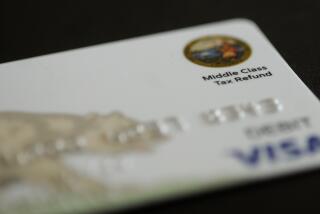Automatic Tellers Take as Well as Give
- Share via
Question: I’ve had the most peculiar experience using my Visa and MasterCards in automatic teller machines. In the past several months I have had about four or five new cards issued to me by both Visa and MasterCard because they turn out to be defective--I put them in the ATM and the machine simply swallows them up. When I go into the bank and they retrieve my card, they test it, pronounce it defective and issue me a new one.
This is getting me a little bit paranoid. People, particularly my husband, look at me blankly and say: “Well, I’ve never had any problems with mine ,” as if this is some sort of a character flaw in me. Also, I’ve had bank personnel tell me that some people seem to have more trouble getting their cards to work in ATMs than others, and that those who do tend to be women.
I had one teller suggest that I am scratching the cards with my fingernails. This is ridiculous--as if I were in the habit of wearing my nails an inch long. Another, if you can believe it, suggested that I carry my cards in plastic sandwich bags! Well, I was frustrated enough to try that , and it didn’t solve the problem either.
Electrical Charge
Most recently--when, once again, the ATM ate my card and it was declared defective--one teller said that she had read an advisory put out by the credit-card people saying that cards carried in eel-skin wallets seemed to be prone to this sort of trouble because eels carry an electrical charge in them that fouls up the magnetic strip, which, of course, carries the individual’s personal identification number.
Since I do carry my cards in an eel-skin wallet, that much of it made sense, but it still seemed weird. The eel, after all, is long dead. In fact, it seemed so odd to me that, after she had issued me still another new card, I stopped by the branch manager’s desk and mentioned it to him. He said it was a ludicrous idea, and to prove his point took my card (from my eel-skin wallet) and put it in the ATM--which immediately swallowed it and left me high and dry for 20 minutes, because, in the interval, the girl with the ATM key had gone to lunch.
You can see why I’m getting a little spooked on the subject. I have since started carrying both cards well removed from my eel-skin wallet and so far (knock on wood) have had no more trouble. But is the idea as dumb as it sounds? Do some people have more trouble with ATMs than others? And, if so, is there any explanation for it more rational than the eel-skin theory?--J.T.
Answer: This is the sort of evil spirit, we’ve been told, that can sometimes be exorcised in a midnight ritual involving a full moon, a toad and a dash of stump water.
No, you can put your mind to rest. It isn’t a character flaw. It happens to other people too, although it’s a long way from being commonplace.
With about four million ATM cards in circulation, for instance, Bank of America, for one, has about 20 instances a month of cards that turn up defective for no visible reason, according to Deborah McWhinney, vice president for the bank’s Versatel card operation.
“Industrywide,” she adds, “defective cards received from the manufacturer total about one-tenth of 1%, although our average is about one-tenth of that . But these are almost always caught before they’re in circulation anyway. They’re scanned electronically twice--first to make sure that the magnetic strip itself is all right and then, after the customer’s identification number has been encoded on it, to make sure that the number ‘took.’ ”
Something Happens
Still and all, something obviously happens to a fractional percentage of the outstanding cards that has nothing to do with either their manufacture and the subsequent encoding of the customers’ identification numbers.
“Since we’re dealing almost entirely with theory,” McWhinney continues, “we tend to take the position when this happens that it’s something that has to do with the customer’s environment--something that affects the magnetic strip on the card.”
The eel-skin theory, she feels, has nothing to do with the eel itself. (She agrees with you that there’s a world of difference between a live, electrically charged eel and a dead one--particularly to the eel.)
“It’s probably due to the fact that her wallet has a magnet in its clasp and it could be made of anything. Inexpensive women’s purses, in particular, “even when they have a snap fastener, almost always have a little magnet in them, too, because it helps direct the snap to the hole,” she says.
This would also explain that other chauvinistic theory advanced to you that most of the people with defective cards “tend to be women.”
What is fairly common knowledge in banking circles is that the direct exposure of an ATM card to a magnet can, indeed, erase the customer’s encoded number. But from there on, McWhinney concedes, it’s pure conjecture.
“We think that when the magnetic strips on two different cards constantly rub together that this can cause a problem, and it’s entirely possible that when you carry a card in your pocket and coins scratch against the magnetic strip that this can be a factor too.”
Another card-in-the-pocket theory: The friction of the cloth rubbing against the strip sets up an electrical field erasing the code. Or: Some people’s bodies naturally create a stronger magnetic field than other people’s.
Strong Magnetic Strips
“The magnetic strips on the cards are quite strong,” McWhinney adds, “but we reissue them after two years, anyway, because we feel that, by that time--the wear and all--they may be getting unstable. Some banks, though, don’t reissue them except after five years and don’t seem to have any problems.
“We have, however, been experimenting with a card with a stronger strip--only about a thousand of them, so far--for these people who have had multiple experiences like this, but they’re quite expensive,” McWhinney says. And then, philosophically: “But we could spend $10,000 researching the problem more broadly without learning much more about it than we know now, so it’s really much cheaper to issue special cards for a few hundred dollars.”
As far as the manufacturers of ATM cards are concerned, according to Larry Lippold, manager of Malco Plastics in Montrose, the banks are bravely keeping their problems with the mystery cards to themselves. As one of the two companies in the country with a stranglehold on the ATM card market, Maryland-based Malco turns out “many millions of cards for all of them--Visa, MasterCard, Versatel--and while there are other problems in the manufacture of the cards, we’re not hearing from any of the banks about this one.
“If we only had problems with 20 cards a month, we’d consider ourselves perfect,” Lippold adds.
Q: I got rid of a ’70 Chevy Nova in the spring of 1985 (I believe it was April). My oldest brother, who was living with me at the time, sold it to a father-and-son team for $25 cash, for junk. When the state asked me to renew my license fees in June, ‘85, I told them that I no longer owned the car. I never got anything from them (nor did I this past June).
Last Friday, I got a notice from the Simi Valley Police Department saying that my car had been found and towed by a local towing company. The company told me it was $48 for the towing and $10 a day for storage (the storage has been in effect since Nov. 24). Until I can prove I no longer own the car (and needless to say, I no longer have the pink slip), I will eventually have to pay these mounting fees. If I can prove it, then the towing company will have to go after someone else. The Department of Motor Vehicles mailed me some forms I have to fill out and mail back to Sacramento, but I haven’t received them yet and meanwhile the clock is ticking.--S.M.
A: In truth, getting rid of a 15-year-old clunker can be as difficult as trying to tell a stray cat that you’ve been feeding for two years that she’s no longer welcome at your home.
Your problem would be non-existent, of course, if you had noted the name and address of the father-and-son team that bought the Nova from your brother, because the key form you’ll be receiving from the DMV will be “Release of Liability--Form 138.” This automatically would have made them liable for the towing and storage fees. (As an alternative you could always dump the whole thing on your brother’s shoulders--blood isn’t necessarily thicker than water--and nail him as the owner. However, he’s a nice guy so we’ll drop that idea).
It’s perfectly natural, of course, that you wouldn’t think to get the name of the buyers of your car, because, at that stage of the game, you were no longer thinking about the Nova as transportation, but as plain old junk. How were you to know that they were going to strip it and leave the shell abandoned on the street?
Surprising Thing
One of the surprising things in your situation, according to Richard Wright, manager of the DMV’s public-inquiry section, is why the police didn’t recognize the hulk as having a value of less than $100 and consign it to the junk yard forthwith, a move that would have spared you any involvement at all.
One of two things can now happen: You may receive from the towing company a “Notice of Intent to Dispose of a Vehicle” form, which comes with an accompanying form--a “Declaration of Opposition,” which you would normally sign if you intend to reclaim the car. (Without serving you with this form, the towing company can’t try to collect storage from you for longer than 15 days). Naturally, if you receive such a form, you simply don’t return it, the towing company sells what’s left of the car, and that’s that.
If you don’t receive such a form, Wright feels, the towing company would probably have to take you to court to try to collect the towing and storage charges. And, for a car that sold for $25 as scrap more than a year and a half ago, such an action seems (personal opinion) unlikely. However, in anticipation of this possibility, Wright is going to send you another form: “Notice of Relief of Liability,” and in the space reserved for the name of the person to which you sold it simply fill in: “Unknown” and return it to the DMV. This, at least, will put you on record as having washed your hands of the car in early ’85.
Next time--junk or no junk--get a name and an address and notify the DMV of the change of ownership.
Don G. Campbell cannot answer mail personally but will respond in this column to consumer questions of general interest. Write to Consumer VIEWS, You section, The Times, Times Mirror Square, Los Angeles 90053.
More to Read
Inside the business of entertainment
The Wide Shot brings you news, analysis and insights on everything from streaming wars to production — and what it all means for the future.
You may occasionally receive promotional content from the Los Angeles Times.










